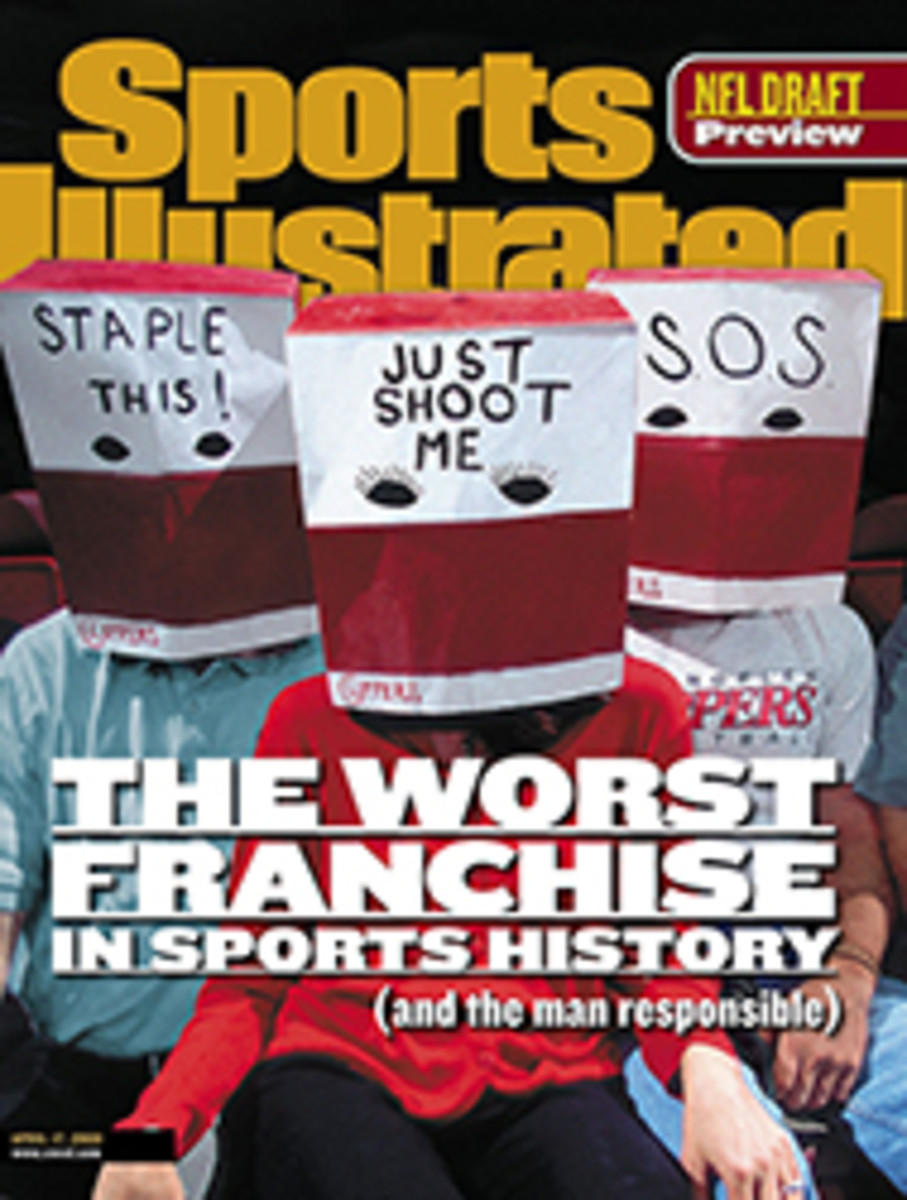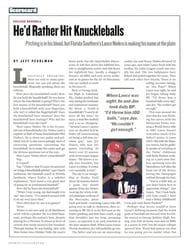
Force Three The hard-hitting young Kansas City outfield storms to the top
He came to Kansas City four years ago, a naive, raw rookie with a
ton of enthusiasm and a dream. Dammit! Mike Levy told himself,
I'm going to be the best vice president of marketing and
communications around! So what if Levy knew absolutely nothing of
his new team, the poor, punchless Royals? Levy may have been
green, but he recognized a catchy name when he heard one. "Johnny
Damon," he purrs. "Just say it--Johnny Damon. It sounds like a guy
in a leather jacket, riding a Harley. A hero's name."
In the world of p.r., who could ask for anything more than a
player with a cool moniker and a warm smile? Within days Levy
arranged a TV promo for the team, starring the then 22-year-old
Damon and retired K.C. star George Brett, in which the two sit in
front of a TV, each holding a remote control. Brett switches the
channel to his preference; Damon switches the channel to his.
"Gimme that!" Brett finally yells, swiping the remote from
Damon's left hand. As the spot ends, Brett turns to Damon and
flashes his 1985 World Series ring. "You've got to win one of
these first."
During the 1996 season, his first full one in the majors, Damon
was asked time and again to compare himself with Brett, a Hall of
Fame third baseman; the questioning reached a point at which
Kansas City executives all but ordered reporters to stop.
"Really, I thought it was a good idea at the time," Levy says of
his marketing ploy. "There just wasn't a lot to say about Royals
baseball."
Deep in the heart of baseball nowhere--in the land of $25 million
payrolls and Buddy Biancalana vigils--resides a trio of young
(average age: 25) outfielders who are fast, powerful, graceful,
personable and obscure. "I hear some people talk about the best
young outfield," says Kansas City lefthander Jose Rosado. "Johnny
Damon, Carlos Beltran and Jermaine Dye are awesome. They aren't
the best young outfield. They're the best outfield."
Last season, as the youthful Royals went 64-97, leftfielder
Damon, centerfielder Beltran and rightfielder Dye combined to
lead all major league outfield trios with 546 hits, 108 doubles,
24 triples, 298 RBIs and 41 assists, while ranking second in
runs, with 304. Last week, as K.C. opened its season by winning
an encouraging five of eight games, Dye picked up where he'd
left off, hitting .419 with five doubles, three homers and seven
runs batted in. Beltran had a homer, seven RBIs and a .265
average. Damon, the leadoff hitter, batted only .222, but on
Monday his ninth-inning solo homer off Minnesota Twins righty
reliever LaTroy Hawkins gave the Royals a 6-5 win.
Damon and Beltran are products of the Kansas City farm system,
drafted in 1992 and '95, respectively; each has classic good
looks, a quick smile and a flashy, almost cocky, on-field
demeanor. When Damon was called up from the Double A Wichita
Wranglers in August '95 and began exhibiting his headfirst
slides, diving catches and penchant for hitting triples (he has
37 in five years), he became a fan favorite and, like it or not,
a potential successor to Brett as Mr. Royal. He still doesn't
like the comparison--"I'm no George Brett, and I probably never
will be," Damon says--but pressure hasn't bothered him since
'92, when, as a senior at Orlando's Dr. Phillips High, he was
regularly introduced before games as "the nation's Number 1
player on the nation's Number 1 team...."
"Can you get any more pressure than that?" says Damon. "Probably
not."
Despite back-to-back seasons in which he averaged 103 runs, 179
hits, 35 doubles, 10 triples, 16 home runs and 31 stolen
bases--numbers that make him one of the best leadoff hitters in
baseball--Damon is unheralded outside of Kansas City and
Orlando. His teammates are appreciative (Royals righthander Jeff
Suppan pumped his fist in salute last Saturday after Damon
robbbed Minnesota's Todd Walker with a sliding catch), and he's
paid a team-high $4 million, but that's relatively paltry by big
league standards. That's why several teams--including the New
York Mets and the New York Yankees--have approached K.C. about
acquiring Damon. "There are clubs with higher payrolls in bigger
markets that would give anything to have Johnny, because he's
the one piece that a club thinks can cement the playoffs or
World Series," says Royals general manager Herk Robinson. So is
he available? "No way," says Robinson. "He's just too important
here."
The same can be said for Beltran, the 1999 American League Rookie
of the Year. Three years ago, while with the Class A Wilmington
Blue Rocks, Beltran batted .229, but that was partly because--out
of the blue--he had decided to become a switch-hitter. "I knew I
would be terrible," says Beltran, who was a natural righthanded
hitter. "I also knew switch-hitting would not just help me reach
the majors but also make me an every-day player." The following
year Beltran batted .276 for Wilmington and then, after a
promotion, .352 for Wichita. Last spring Royals manager Tony
Muser kept Beltran on the Opening Day roster for his defense and
got offense. Beltran hit .293 with 112 runs, 22 homers and 108
RBIs, becoming the first rookie to clear both 100 runs and 100
RBIs since the Boston Red Sox' Fred Lynn in '75. This year
Beltran's outfield play is receiving added respect, as evidenced
in Sunday's 13-7 Minnesota victory by the way Twins coach Ron
Gardenhire held base runner Torii Hunter at third on a Cristian
Guzman single rather than test Beltran's arm. "I've said this all
along," says Damon. "Carlos is the most gifted baseball player
I've ever seen."
Folks have never uttered such words about Dye, although when he
arrived on the campus of Cosumnes River (Calif.) Community
College as a freshman in 1992, coach Rod Beilby thought Dye had a
potentially dominant arm. After all, Dye, a pitcher out of Will
C. Wood High in Vacaville, Calif., had been drafted by the Texas
Rangers in the 47th round. (He didn't sign.) "I remember his
first game for me. He threw the ball up, down, wide left, wide
right," says Beilby. "I said, 'This guy's an outfielder.'"
His slingshot arm--Dye led his minor league in assists in 1994
and '95, with 22 each season--was a big reason the Atlanta
Braves called him up in '96 as a replacement for the injured
David Justice. Dye wound up hitting 12 homers in 98 games and
started in the World Series. But the following spring the Braves
traded him to Kansas City, beginning a downward spiral in his
career. Dye was on the disabled list four times in two years,
including a season-ending stint in '98 after he tore cartilage
in his right knee while stepping into his Lexus in a Wal-Mart
parking lot.
Shortly thereafter Dye was hunting in the woods outside Kansas
City when he tripped and fell into a bush of thorns, opening a
gash on his right cheek. Two thick scars remain. "I've had a lot
of little problems," says Dye, "but frustration does nobody any
good. I knew, given the chance, I could thrive." Last season, in
his first full year in the majors, he batted .294 with 44
doubles (tied for second in the American League), 27 home runs,
119 RBIs and 17 assists (a single-season Royals record that tied
him for the league lead). "Jermaine puts up superstar stats,"
says third baseman Joe Randa, "but he's not the kind of guy to
beg for attention."
Memo to Mike Levy: Get on this. Now.
COLOR PHOTO: CHUCK SOLOMON [T of C]
COLOR PHOTO: DARREN CARROLL ALL-OUT With his hell-bent style, dashing Damon snared a foul fly by the Twins' Walker last Saturday.
Royal Runaround
Last season Kansas City's unheralded outfield of Carlos Beltran,
Johnny Damon and Jermaine Dye combined to drive in more runs
than any other outfield trio in the major leagues, including the
star-laden threesomes below.
TEAM OUTFIELD RBIS
Royals Carlos Beltran, Johnny Damon, Jermaine Dye 298
Orioles Brady Anderson, Albert Belle, B.J. Surhoff 282
Rockies Dante Bichette, Darryl Hamilton, Larry Walker 265
Braves Andruw Jones, Brian Jordan, Gerald Williams 264
Indians David Justice, Kenny Lofton, Manny Ramirez 264
SOURCE: ELIAS SPORTS BUREAU

